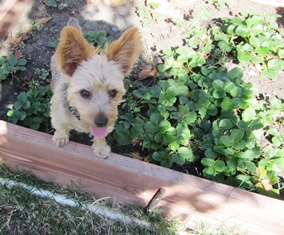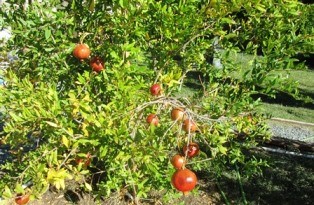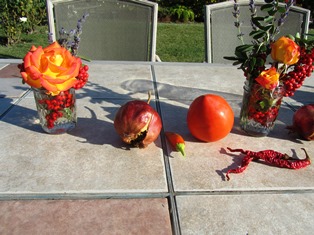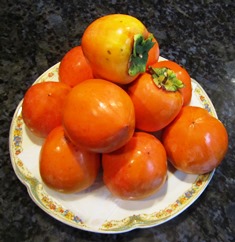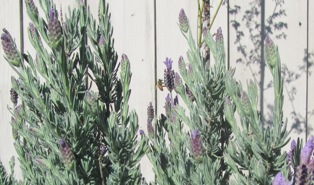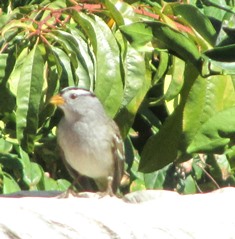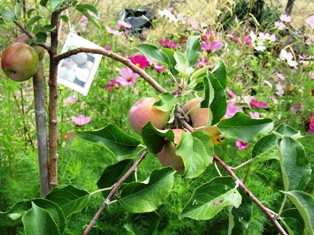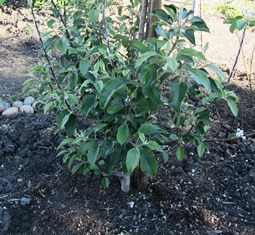Archive for the 'Uncategorized' Category
Ginger Tea for Colds and Flu
I’ve caught it . . . that nasty little bug affecting the throat and gut. Despite my best hygienic efforts at not catching the malady that many of my friends have recently endured, I have come down with it.
It started as a scratchy sore throat. Then a queasy stomach. Hoarseness and discomfort when swallowing followed. And the queasiness intensified to the point where even the sight of food sickened me. Oh, joy! Just what I didn’t want for the upcoming Thanksgiving week!
It’s always a good idea when you’re coming down with a cold or flu to increase your intake of fluids–herbal teas, juice, water, and popsicles. My former Chinese Tai Chi teacher advocated ginger tea to treat this type of malady; it’s my favorite home treatment for colds and flu.
Honey soothes the inflamed throat passages. Ginger settles the stomach. In fact, ginger has been used medicinally for 2,000 years in China to treat stomach upset, nausea, flatulence, and diarrhea.
GINGER TEA WITH HONEY
Ingredients:
1.5 inches of peeled and sliced fresh ginger root (about 1/2 cup)
5 to 6 cups of water
optional: 1/2 lemon, washed and sliced
optional: 2 sticks of cinnamon
honey or brown sugar, to taste
Directions:
Pour the water into a sauce pan.
Drop in the slices of ginger. Optional: add slices of lemon and cinnamon.
Simmer for 10 minutes.
Pour tea into a cup.
Stir in honey or brown sugar to sweeten.
Enjoy.
Try Having a Cup of Tea with These Dogs
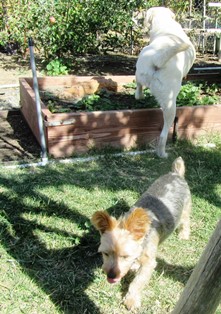
Remington, the white, short-haired lab, is trouncing over the strawberries, while Moose has his sights set on the chickens
I just wanted a nice cup of tea and to sit on the grass and sip it while listening to the birds and watching my bees and chickens. Fat chance. It would take five minutes flat for my daughter’s little dog Moose to knock over the cup, spill the tea all over me, and then traumatize my chickens so badly that their egg-laying is now out of wack; they’re just squatting and dropping.
As a favor to my lovely daughter and her family, I agreed to dog sit on my farmette for four days. My daughter assured me the two family pets would enjoy four days of freedom to romp around our acreage despite one of her dogs being a little high strung. His breed used to chase rats, she said. I didn’t make the correlation. It didn’t seem to matter then.
I reminded her that my bees and chickens both forage freely over the land. The chickens would necessarily have to remain in their chicken run during that period since the dogs might chase them. The bees probably wouldn’t bother the dogs, but I’d take the name of her vet, just in case. Of course, the dogs might not actually like it here.
In retrospect, I believe I underestimated my concerns. Oh, the dogs seem happy enough; it’s my sanity I’m worried about.
The Irish lab named Remington has had some professional training. He is a lovely, well-behaved gentleman. I enjoy him and wish I could same the same for the small dog with the mighty name of Moose who is high-strung, has allergies, and arrived with special gluten-free food, his round bed, and a bag of medications, including a vet-prescribed tranquilizer.
Moose barks a lot. It’s an annoying high-pitched bark. In the yard yesterday, when he wouldn’t stop, I heard my neighbor barking back . . . and that’s just ridiculous!
I thought Moose was going to have a meltdown when he discovered the chickens, barking at the highest decibel he could muster, running the length of the chicken run in one direction with the chickens one step ahead on the inside their poultry-wire pen before hitting the wall where the dog and chickens reversed their direction.
I got half as many eggs yesterday and found two on the ground instead of in the nesting boxes. When the chickens free-range, they always return to the nesting boxes in the hen house to lay their eggs. It’s like they got so scared, they forgot not only where to go but how to properly lay their eggs. I hope things return to normal when the dog visit is over.
I decided to spend the day outside, doing chores like digging planting holes at the front of the property. Moose saw it as a game so as soon as my back was turned, he refilled the holes, pawing like a dog on a mission. I finally gave up on that. The shovel and rake seemed to scare him, so I put those away. And he didn’t like me playing ball with him or the other dog. So we quit on that, too.
By the day’s end though, both dogs seemed tuckered out. Both wanted to sleep in our room. The big dog contented himself in his bed on the floor (by my husband’s side of the bed), but the high-maintenance Moose threw himself onto my pillow, pulled my fleece bathrobe over his head, and nodded off like he owned the place.
When our alarm went off at four o’clock as it does every weekday morning, the yip-yip-yipping and chaos started all over again. Only three more long days and nights left.
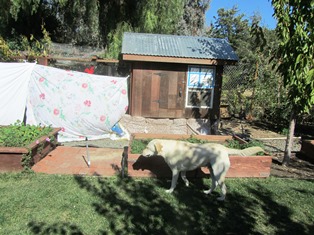
Remi wasn’t the problem but with Moose frightening the chicken feathers off my hens, I draped the chicken run in sheets
I’m going to need a vacation when these four days are over. I just hope my chickens will resume their egg-laying schedule once I take the sheets down off the chicken run (I hung them so Moose couldn’t see the chickens) and I have the energy and some decent weather ahead to re-dig those planting holes. I look forward to having a cup of tea again, too, while I listen to the birds and quiet clucks instead of that shrill yip-yip-yip, amplified by by neighbor’s imitation of it. Ridiculous!
How to Repay the Thoughtful Gift of a Truckload of Manure
I begin obsessing about soil and manure this time of year after the summer garden is gone. The old adage of: take care of the soil and it will take care of you (via your plants) is really true. Out here on the farmette, the clay soil is so heavy that it cracks open in fissures during summer, so we are always working to improve it.
Recently, a generous friend brought us a truckload of horse manure. It was no small truck either. The manure seemed mostly aged and I could easily rake it into our flower beds and little lawn. Some of though is still relatively green, not aged, and I worry about using it to grow my winter crop of vegetables for fear of E-coli contamination.
There’s a new area where we are debating or not to put down a stone floor and just grow trees and flowers in a container wall on two sides. It might be the perfect place to use some of that horse dung.
In the meantime, on the property behind ours, the horse manure has been spread out with a bobcat to keep the growing areas fertile for the trees that were planted there nearly four or five decades ago.
There are all kinds of manures one can use in the garden, from bat guano and worm casings to animal waste products–horse, cow, sheep, steer, turkey, rabbit, and chicken, for example.
You can get manure tested, much like you can soil, to detect levels of nitrogen, phosphorus, and potassium. Not all manures are high in nitrogen, which is loved by many gardeners for that sudden growth and burst of bloom. Some manures, like cow and horse, also can carry seeds of weeds or whatever the animal has grazed on, which can emerge in your garden.
Most manures can be made into a fertilizer “tea” by mixing with water. Whether you apply aged manure or manure tea, always wash your fruits and vegetables well before eating to reduce the risk of consuming contaminated fruit or produce.
We appreciate our friend’s gift. Now . . . we wonder how to repay his kindness. I’m thinking a basket of persimmons and pomegranates, a French sugar pumpkin, a dozen organic eggs, and jars of jam and honey.
The Bee Garden Favorites
I spent Sunday building a rock circle around the circumference of our towering elm tree. I want to conserve water around the base of the tree and to also grow more plants for my bees to have abundant food.
We had a pile of river rock donated to us, so I thought it might look nice to create a wide circle, maybe three feet high around the tree like a watering basin/retaining wall, using the rock.
Inside the circle, I transplanted some yarrow and white geranium. Already, there are white roses that boom all summer long under the tree.
But bees like nectar-rich plants with pollen, so I’ve put together a list. Over the next week, I’ll add some of these in my new bed beneath the elm. This is a partial list of plants bees love.
- Rosemary
- Lavender
- Russian sage
- Basil (African blue)
- Honeywort
- Mexican Sunflower
- Borage
- Cerinthe
- Greek oregano
- Sweet marjoram
- Purple coneflower (echinacea)
- California poppies
- Lupine
- yarrow
- sunflowers
Eucalyptus on the property behind our farmette is not yet covered with fall bloom. The bees love that bloom but now they make do with the star thistle on the brown hillsides and by foraging on the French perfume lavender and the Spanish variety in my garden.
Of late, I’ve discovered the honeybees foraging on the sweet nectar at my hummingbird feeders, so I worry about them getting enough food. The drought has sapped everything. At any rate, I’ll hold off taking honey this fall, leaving it in the hives for the bees. They’ll need food to get through the rainy season.
A 6.1 Quake Shakes Up the Napa Wine Country
Our neighbor (two houses down) called to say he wanted some of my Henny Penny Farmette honey and would be at the front door at 7:30 a.m.
I was out feeding the chickens, but after my husband gave me the message, I got a jar off the shelf and went to meet our neighbor. He asked me if I’d heard about the quake that had happened at 3:20 a.m., centered in American Canyon, about five miles southwest of Napa.
I hadn’t felt it, but his wife had. Napa is exactly 34 miles from our farmette and it was a fairly large quake at 6.1, according to seismologists. The 1989 Loma Prieta quake, by contrast, was a 7.0 quake on the San Andreas Fault, a major fault line.
The Loma Prieta Quake is the one I’ll never forget. At 5:04 p.m., it interrupted a Bay Area World Series game that my husband attended with a buddy. Candlestick Park went dark and San Francisco, because of broken gas lines, erupted in flames. My husband couldn’t get back home until 4:00 in the morning.
According to Dan Vergano, writing for National Geographic, the Napa Valley quake likely was caused by a series of cracks beneath the earth “tied to the famed and feared San Andreas Fault.
Vergano went on to say that some early reports suggested that the quake may have been provoked by the Franklin Fault that has been dormant for 1.6 million years. See http://news.nationalgeographic.com/news/2014/08/1400824-earthquakes-usgs-napa-california-faults-science/
The news reports videos on local television stations showed cracks through vineyards and across Highway 121 as well as wine bottles strewn on the floor at wineries. See, https://www.yahoo.com/travel/this-is-what-it-looks-like-when-an-earthquake-hits-wine-95640002407.html
The Napa airport control tower lost its windows. The Gold Rush-era buildings downtown are badly damaged, some in spite of earthquake retrofitting. The quake ran roughly 6.7 miles beneath Napa wine country (by contrast the Loma Prieta quake ran about 11 miles deep).
The cleanup is on; the community is pulling together as our Bay Area folks and first-responders always do in times of emergency or natural disaster.
Those Entertaining Rascals, the Sparrows
I enjoy watching the sunrise over the hills that jut up between the inland valley of the East Bay, where I live, and the waters of the delta flowing down from Sacramento to dump into the Straits of Carquinez before entering the San Francisco Bay. A lot goes on in our backyard garden at sunrise.
With feeders filled with birdseed, all sorts of songbirds visit to eat before bathing in the bird bath perched in a raised bed of blooming geraniums, asparagus ferns, and foxglove flowers. The squirrels search feeders for sunflower seeds. And clusters of house sparrows twitter away as they forage for seeds, insects and other interesting morsels to devour.
These cutie pies descend to the lawn as soon as the sun is up. They bathe, drink, and eat, often stealing food from other birds. A robin with a beak full of worms better take heed of the presence of sparrows or those little cheep, cheep, cheepers will steal the food right out of the robin’s beak.
The sparrow’s thievery isn’t limited to food; no, it will also steal nesting material from each other’s nest. But these scrappy little fellows will just as readily engage in their birdbrain version of fisticuffs as they will dart into trees for cover.
Without a doubt, of all the birds that are visiting the garden of late, the sparrows provide hours of entertainment.
Blending Your Own Herbs de Provence
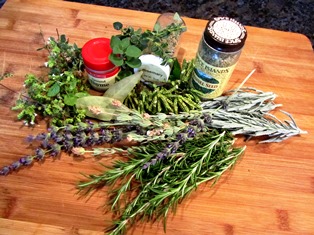
The name Herbs de Provence originated about 40 years ago for a blend of herbs that grow in the Provence region of France
My fingers are lusciously scented this morning with the oils of rosemary, thyme, oregano, lavender, and mint that I’ve just gathered from my garden. Herbs play an important part in the seasoning of many foods of the world, including the blend famously known as Herbs de Provence. But did you know that you could make your own Herbs de Provence?
A basic blend that cooks in the south of France use often includes savory, fennel, basil, rosemary, and thyme. Americans associate lavender with Provence, so the commercial spice companies have blended lavender in as well for the American market. Depending on the cook, she might also add to the basic blend some sage, bay leaf, chervil, French tarragon, and even mint.
If you’d like to create your own blend, start with equal parts of the following dried herbs: thyme, rosemary, savory, marjoram, and chervil. Judiciously add some lavender. Be equally cautious about adding fennel seeds and French tarragon, since both herbs taste of liquorice and can quickly overpower, even ruin, your mixture.
Friends, Figs and Goat Cheese, and a Bee Swarm
Yesterday held a surprise for us. It was lovely late-summer weather, not too hot and not too cool. As my neighbor’s husband chatted with mine in the front yard, I went to the back of the farmette to work on pulling weeds from my garden. That’s when I heard the bees buzzing in flight. I saw them swarm.
It’s kind of late in the season for a bee swarm. All I can figure is that we fed the bees a week or so ago when we took honey and closed the hives for the fall. The hives are strong and one hive, in particular, must have had two queens.
So, I grabbed a metal lamp and a stick and began clanging to keep the swarm close and it alighted on the fence. My neighbor retrieved a box with some frames with wax and the swarm moved in.
The rest of my neighbor’s family, their children, and another family gathered on my patio. We shared wine and conversation. I put out a large cutting board of fresh strawberries, goat cheese, pistachios, and crackers and my neighbor brought over figs and a thin-crust pizza cut into slices.
It was an altogether lovely way to watch the sun go down on a late Sunday afternoon. I don’ t think we’ll have any more swarms this year. We’ve reduced the hive size and given the bees food to help them through the winter. Hopefully, the next swarms will occur in late spring–the right time for swarming.
Making A Flower Essence In Eight Easy Steps
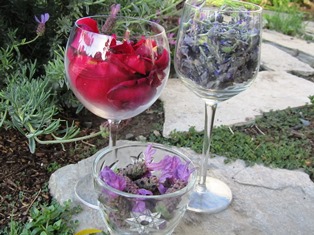
Rose petals, Spanish lavender, and French perfume lavender each can be used to make a flower essence
Although flower essences technically are not made for scent or perfume, some flowers carry their scent along with their subtle energy vibration that is stored in the flower petals used to create the essence. Flower essences can be used in aroma therapy or as a tincture that can be consumed for health and well being.
Flower-derived essential oils provide potent scent, but I’ve made flower essences (not essential oils) that also offer scent. You can, too. The process is simple and involves eight steps.
You’ll need bottles (sterilized) with stoppers or caps, tweezers (to pluck flower petals), glass bowls to hold the petals, sterile spring water, and brandy (as preservative).
Because you don’t want to introduce any contaminants into the essence, do not use your fingers to touch (contaminate) the petals, water, or brandy during the process.
Use only organically grown flower petals that you’ve gathered during the early morning hours when your flowers are freshest. Sterilize the stopper bottles in boiling water.
Using your tweezers, pluck the rose petals, lavender tips, or other flowers. You can mix rose varieties, but don’t mix rose petals with other flowers. Note: the Spanish lavender scent is slightly different than the French perfume lavender.
Step 1. Gather your petals or flower heads and put them into a glass container (bowl or large mouth wine glass).
Step 2. Add the sterile water to cover.
Step 3. Place in direct sunlight (cloudless days in spring and summer are best) and leave for at least 3 hours.
Step 4. Use tweezers to remove the flowers and any debris from the water.
Step 5. Fill your special stopper bottles half full with brandy.
Step 6. Pour the flower water to fill the bottle to the neck.
Step. 7. Seal the bottle with a stopper and label the bottle with the type of flower essence and the date.
Step 8. Shake the bottle gently several times. Now your flower essence is ready to use.
Rose essence (like a rose essential oil used in aroma therapy) can balance the emotions, while lavender is considered a stress reducer.
Mulching Do’s and Don’ts
An area of the garden where we planted apple trees two years ago had become so overgrown with weeds that it required many hours of weeding.
Following the weeding, we added organic mulch. I like to create an area as large as the canopy of the tree around the base of the tree (free of any plants or weeds) so that I can easily feed and water our fruit trees throughout the growing season. Then I reapply the mulch.
Mulching with organic material makes it easier to prevent the germination of weeds, facilitate watering and feeding of the fruit trees, encourages the proliferation and activities of earthworms (good for improving the soil), and keeps the soil moist (reducing the amount of water needed).
When adding organic mulch to the top of the soil, the keep in mind the following tips.
1. Do dig in high-nitrogen products such as chicken manure, blood meal, or cottonseed meal into the soil around the plant or tree before layering atop the soil low-nitrogen mulch such as bark, wood chips, or decayed sawdust material.
2. Do pull mulch back from over bulbs and perennials in the spring to facilitate a faster start to their warming and growth cycle.
3. Be aware of snails and slugs that can hide in damp mulch. Try placing a layer of newspaper where you think the snails and slugs might be proliferating. Put the paper down on the soil at night and retrieve it before sunup when you can turn it over to see the pests clinging to it. Dispose of the newspaper in the garbage.
3. Don’t mulch too close to the stems of shrubs or trees s since wet mulch and cause stem rot; ensure that the mulch is at least an six inches away from a shrub stem or tree trunk.
4. Don’t pile mulch too deep; doing so encourages rodents such as voles, rats, and mice to use the mulch for nests.
 Facebook
Facebook Goodreads
Goodreads LinkedIn
LinkedIn Meera Lester
Meera Lester Twitter
Twitter





